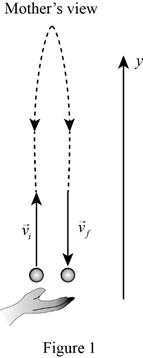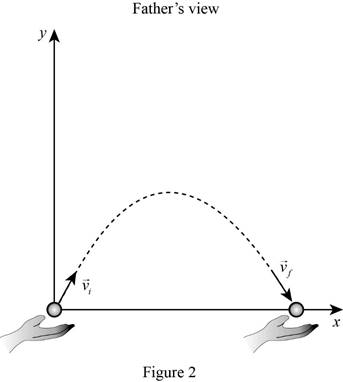
A mother pushes her son in a stroller at a constant speed of 1.52 m/s. The boy tosses a 56.7-g tennis ball straight up at 1.75 m/s and catches it. The boy’s father sits on a bench and watches.
a. According to the mother, what are the ball’s initial and final momenta?
b. According to the father, what are the ball’s initial and final momenta?
c. According to the mother, is the ball’s momentum ever zero? If so, when? If not, why not?
d. According to the father, is the ball’s momentum ever zero? If so, when? If not, why not?
(a)
The initial and final momentum of ball according to mother’s view.
Answer to Problem 4PQ
The initial momentum is
Explanation of Solution
Consider the figure showing the motion of ball on the basis of mother’s point of view.

According to mother’s point of view, the ball moves vertically upwards and falls vertically downwards with same speed. But initial momentum is in positive y direction and final momentum is in negative y direction.
Write the expression for initial momentum.
Here,
Write the expression for final momentum.
Here,
Conclusion:
Substitute,
Substitute,
Therefore, the initial momentum is
(b)
The initial and final momentum of ball according to father’s view.
Answer to Problem 4PQ
The initial momentum is
Explanation of Solution
Consider the figure showing the motion of ball on the basis of father’s point of view

The path of ball is now parabolic, horizontal velocity is same as those observed by mother, but vertical velocity is equal to the velocity of stroller.
Write the expression for initial momentum.
Here,
Write the expression for final momentum.
Here,
Conclusion:
Substitute,
Substitute,
Therefore, the initial momentum is
(c)
Whether the momentum of ball is zero ever according to mother.
Answer to Problem 4PQ
The momentum will be zero according to mother’s point of view.
Explanation of Solution
According to mother’s view the ball is in vertical motion. At maximum height the kinetic energy is completely converted to potential energy, and velocity of ball is zero, or ball is momentarily at rest.
Momentum is the product of mass and velocity, thus, if velocity is zero, momentum will be zero, at top of flight.
Conclusion:
Therefore, momentum will be zero, at maximum height according to mother’s view.
(d)
Whether the momentum of ball is zero ever according to father.
Answer to Problem 4PQ
The momentum is never become zero according to father’s view.
Explanation of Solution
The motion is parabolic according to father’s view, and has two components of velocity, horizontal and vertical. Even though vertical component become zero, at any point, the horizontal component remains same until the ball covers entire parabolic path.
Hence momentum will not be equal to zero.
Conclusion:
The total velocity is the sum of horizontal and vertical velocity, since horizontal velocity remains same as a nonzero value, momentum is never become zero.
Want to see more full solutions like this?
Chapter 10 Solutions
Physics for Scientists and Engineers: Foundations and Connections
- please solve and answer the question correctly. thank you!! (hint in 2nd photo)arrow_forwardNewton's Laws of Motion - Please help with the first angle calculations of standard deviation and margin of error. I just need a model and I can figure out the other two angles. Thanks!arrow_forward2. A battleship simultaneously fires two shells at enemy ships. If the shells follow the parabolic trajectories shown, which ship gets hit first? a. A b. both at the same time C. B d. need more information battleship Barrow_forward
- A m₁ = 1.70-kg aluminum block and a m₂ = 8.00-kg copper block are connected by a light string over a frictionless pulley. The two blocks are allowed to move on a fixed steel block wedge (of angle 0 = 31.5°) as shown in the figure. (For aluminum on steel, μk k = 0.36.) Мк Aluminum m Copper = 0.47. For copper on steel, Steel m2 Ꮎ (a) the acceleration of the two blocks m/s² (b) the tension in the string Narrow_forwardWhile the 83.3 kg Dora Milaje is in equilibrium, the rope makes a 70.0˚ angle with the horizontal. Assuming the coefficient of friction between her shoes and the ship is 0.772 and her static friction is at its maximum value, what is the tension in the cable?arrow_forwardCan someone help me asnwer this thank youarrow_forward
- Please solve and answer the problem correctly please. Be sure to give explanations on each step and write neatlyplease. Thank you!! ( preferably type the explantion, steps and solution please )arrow_forwardA square coil that has 17.5 cm on each side containing 17 loops lies flat on your desk as shown on this page. A uniform magnetic field of magnitude 4.60 × 10-ST points into this page. If a 8.50-A clockwise Current flows through the coil. ca) determine the torque on the coil. N.m (b) which edge of the coil rises up? choose one 。 Bottom отор and explain. O Right • None of these О Left.arrow_forwardA circular loop of wire with a diameter of 13.0 cm is in the horizontal plane and carries of 1.70 A clockwise, as viewed from underneath. What is the magnitude magnetic field as the center of the loop? -T what is the direction of magnetic field at the center or down? please explain. of the loop? uparrow_forward
 Physics for Scientists and Engineers: Foundations...PhysicsISBN:9781133939146Author:Katz, Debora M.Publisher:Cengage Learning
Physics for Scientists and Engineers: Foundations...PhysicsISBN:9781133939146Author:Katz, Debora M.Publisher:Cengage Learning University Physics Volume 1PhysicsISBN:9781938168277Author:William Moebs, Samuel J. Ling, Jeff SannyPublisher:OpenStax - Rice University
University Physics Volume 1PhysicsISBN:9781938168277Author:William Moebs, Samuel J. Ling, Jeff SannyPublisher:OpenStax - Rice University Principles of Physics: A Calculus-Based TextPhysicsISBN:9781133104261Author:Raymond A. Serway, John W. JewettPublisher:Cengage Learning
Principles of Physics: A Calculus-Based TextPhysicsISBN:9781133104261Author:Raymond A. Serway, John W. JewettPublisher:Cengage Learning Physics for Scientists and Engineers with Modern ...PhysicsISBN:9781337553292Author:Raymond A. Serway, John W. JewettPublisher:Cengage Learning
Physics for Scientists and Engineers with Modern ...PhysicsISBN:9781337553292Author:Raymond A. Serway, John W. JewettPublisher:Cengage Learning College PhysicsPhysicsISBN:9781285737027Author:Raymond A. Serway, Chris VuillePublisher:Cengage Learning
College PhysicsPhysicsISBN:9781285737027Author:Raymond A. Serway, Chris VuillePublisher:Cengage Learning College PhysicsPhysicsISBN:9781938168000Author:Paul Peter Urone, Roger HinrichsPublisher:OpenStax College
College PhysicsPhysicsISBN:9781938168000Author:Paul Peter Urone, Roger HinrichsPublisher:OpenStax College





